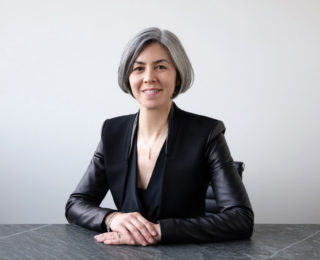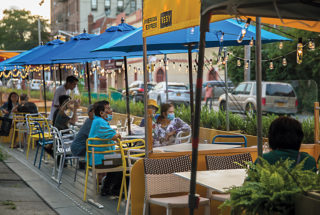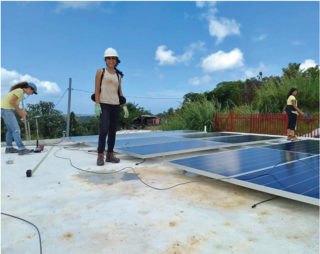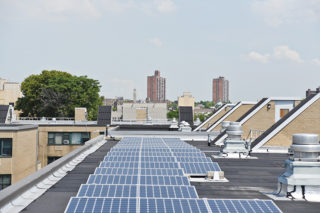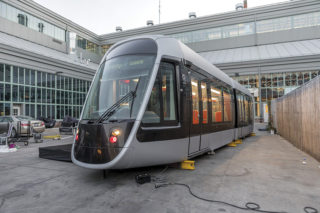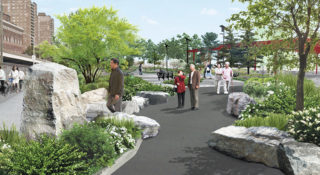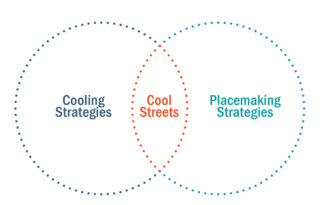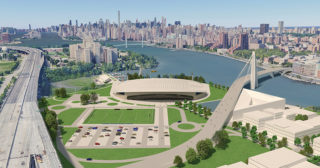The COVID-19 crisis has exposed what many have known but rarely acknowledge: New York City’s communities of color carry a disproportionate environmental burden created by our consumption economy. And they are being crushed under its weight.
All across the U.S., low-income minority neighborhoods are more likely to have heavy polluters as neighbors, simply because they lack the resources and connections to push them away. Whether it’s toxic emissions from power plants along “Asthma Alley” in Astoria, or the noxious waste transfer stations in the South Bronx, New York City is complicit in this type of environmental racism.
As a design community, we have an obligation to be leaders in the environmental justice movement.
Step one is to broaden our understanding of how the decisions we make affect New York City’s environmental justice (EJ) communities. EJ communities are defined as census block groups in which 51% or more of the residents report themselves to be members of minority groups, and 23% or more have household incomes below the federal poverty level. At HOK, we are beginning to address equity as a key output in our environmental life-cycle analyses for projects.
One could argue that we have a moral imperative to design net-zero energy buildings, as this would lighten the pollutant load inhaled by residents of EJ communities. According to the Harvard School of Public Health, poor ambient air quality has contributed more to the COVID-19 death rate than preexisting medical conditions, socioeconomic status, and access to healthcare. In New York City’s initiative “Take Care New York 2020: Community Health Priorities,” five of the 10 communities surveyed listed air quality as their number one health concern. Doubling down on energy performance will carry the added benefit of mitigating the climate change impact our buildings have on EJ communities, which are more likely to suffer during climate-related disasters.
Another “Swiss Army Knife” solution we can effect in EJ communities is well-designed natural space. Parks and places of play are known to improve social cohesion, a key determinant of resilience, and they are in severe deficit in EJ communities. Well-designed natural spaces provide an array of health benefits by reducing stress, boosting air quality, promoting physical activity, and allowing for hyperlocal food production. They decrease water pollution by eliminating stormwater runoff and can help reduce crime. Natural spaces also lessen urban heat island effects, which can accelerate heat-related illnesses and death among vulnerable populations. As climate change continues and the number of extreme-heat days increases, these problems will be exacerbated.
We, the design community, hold the technical and leadership skills to implement these projects. Designers can’t just wait on RFPs for these spaces to land in our laps. We must proactively engage EJ communities, collaborate to develop creative, low-tech, and cost-effective solutions, and then aggressively advocate for construction funding.
The ultimate NIMBY issue is waste. The Center for Architecture has demonstrated leadership in this area with the Zero Waste Design Guidelines, and Local Law 152 of 2018, known as the “waste equity bill,” was also a strong step in the right direction. Yet our actual performance has been terrible.
The NYC Department of Sanitation reported a recycling rate of less than 20% in 2019. Think about that: More than 30 years after New York City passed its mandatory recycling law, we’re still sending more than 80% of our waste to landfills. Clearly, the status quo isn’t working. With waste transfer stations often located in EJ communities, our unwillingness to reduce waste carries serious consequences for our fellow New Yorkers.
Waste is a design problem. Instead of reacting to waste that has already been generated, we should focus our design intellect upstream to create efficient systems that generate less waste to begin with. Though it has been an AIA Committee on the Environment Top Ten Awards metric for years, Design for Disassembly, or reuse at the end of a building’s useful life, remains a promise largely unfulfilled. On tight construction sites, contractors regularly feed architects a narrative that the only way to deal with construction and demolition waste is offsite at a co-mingled facility, which nearly always is in an EJ community. Don’t we have an ethical obligation to push back and work harder to alleviate that burden?
In what will likely be a post-COVID-19 period of austerity for New York City, we should focus on multifaceted solutions that solve multiple problems simultaneously. When we demonstrate the value proposition of generating a rising tide that lifts all boats, we can leverage our proximity to some of the world’s most valuable companies and the city’s generous philanthropic community to attract more EJ-focused investment.
If the COVID crisis has taught us anything, it’s that there are no such things as externalities. The severe economic and social costs are real and painful, and they have the potential to tear our city apart.
I previously considered “2020 Vision” as a phrase to describe the potential of this decade. It now seems a well-fitting description of how clearly we can see the disparities that exist in our city. With clear vision, we now face a “2020 Crossroads.” The crises we confront have shaken many of us awake, and we have the rare opportunity to make a generational course correction.
Do we continue along a “change as usual” path, nibbling at the edges and hoping everything works out? Or do we turn, face the wind, acknowledge our failings, and proceed to take New York City in a direction where we work to protect the health, safety, and welfare of everyone?
Standing at this crossroads, I vote for the latter.








